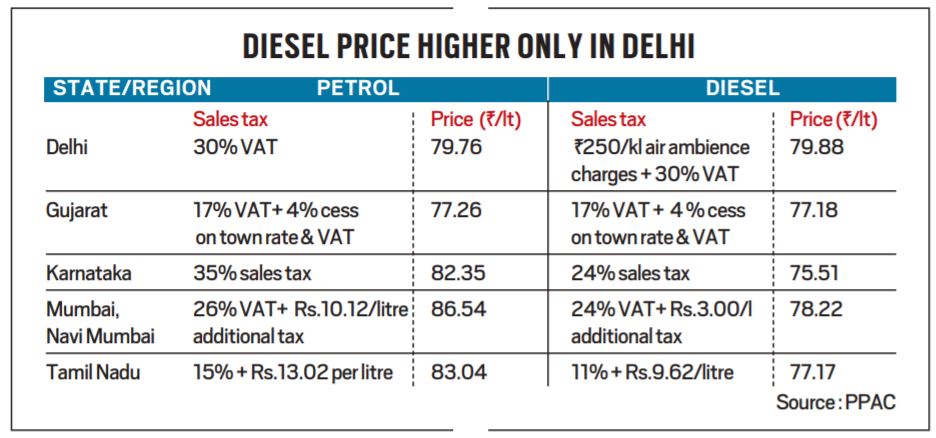Why in news?
- The price of diesel in New Delhi surpassed the price of petrol for the first time.
- Here is a look at why diesel has become more expensive than petrol in Delhi.
What is the current price scenario?
- The OMCs (Oil Marketing Companies) hiked the price of diesel by 48 paise per litre to Rs 79.88.
- On the other hand, the price of petrol stands at Rs 79.76, not hiked for the first time in 18 days.
- The price of petrol has risen by Rs 8.5/litre and the price of diesel has increased by Rs 10.5 per litre since June 7, 2020.
- That was when the OMCs began revising the prices of petrol and diesel after an 82-day gap.
- The interval was the period during which the international price of crude oil fell to below $20/barrel.
Why is this significant?
- The price of diesel has traditionally been lower than that of petrol.
- Diesel price also continues to be lower in other parts of the country, except for Delhi.
Why has this happened in Delhi?
- In May 2020, the Delhi government increased the VAT on diesel to 30% from 16.75% and that on petrol to 30% from 27%.
- Notably, diesel also attracts an additional air ambience levy of Rs 250/kilolitre in Delhi.
- Before the change, the price gap between petrol and diesel stood at Rs 7.3 in Delhi.
- The increase in VAT reduced the price gap between petrol and diesel to Rs 2.
- This gap has been closed eventually with OMCs hiking diesel prices more than petrol prices.

Why were prices frozen and why are they rising now?
- The OMCs had decided to stop revising the prices in line with the falling international prices in late March and April 2020.
- This is because, in OMCs' view, doing so would have led to negative margins for them.
- They thus considered the move unsustainable.
- Now, various countries are easing the restrictions imposed to curb the spread of Covid-19.
- So, the international prices of both diesel and petrol are rising due to increasing demand.
- The price of Brent crude has risen to around $42/barrel.
- So, the oil marketing companies are now revising the prices in line with international prices of petrol and diesel.
How are taxes a determining factor?
- The OMCs stopped revising prices from March 16 to June 7, 2020.
- During this period, international prices of crude oil hit historic lows.
- In other words, the revisions in the prices of diesel and petrol during this time were only a result of changes in state taxes.
- [As of now, fuel has been kept outside the purview of GST.]
- Price gap - In most states, there is a greater hike in the price of diesel than the price of petrol over the past 18 days (since June 7, 2020).
- But, they have maintained lower tax rates on diesel than on petrol.
- This is keeping the price of diesel below the price of petrol despite the price hike.
- [In contrast, the price of diesel and petrol are almost equal in Ahmedabad as the VAT on both petrol and diesel are the same.]
- There is also very little difference between international prices of petrol and diesel currently.
- So, the taxes have become the key component in maintaining a price difference between petrol and diesel.
- Revenue - The prices of petrol and diesel are determined by various factors.
- First, the cost of crude oil, and second, the taxes the Centre and states impose.
- There is also the dealer's commission and VAT that gets added before it is sold to the consumer.
- Petrol and diesel are expensive, primarily, because of the central and state taxes; otherwise, it would be much cheaper.
- Taxes on fuels are a huge revenue generator for the government.
- So, it is a tough decision for the governments - Centre and states - to cut taxes to reduce fuel prices.
What is the oil pricing mechanism in India?
- India follows a dynamic pricing system that reflects the fluctuations in global oil market.
- Earlier petrol prices were revised every fortnight.
- Under that, the prices changed on the 1st and 16th of every month.
- However, on June 16, 2017, a new scheme was implemented.
- There was a shift from administrative price mechanism (APM) to dynamic pricing.
- Under the new mechanism, prices were to be revised every morning at 6 am by the OMCs.
What is the rational behind this?
- One of the crucial differences between APM and dynamic pricing is price decontrol.
- Earlier, private companies protested government-controlled pricing saying that it reduced their profitability.
- It also impacted competition, leaving consumers with little choice.
- With the new mechanism/market pricing, there was better competition.
- The change was done to ensure that the benefit of the smallest change in international oil prices could be put into effect by dealers.
- So, importantly, it was meant to benefit the consumers and bring parity with international product prices.
- Also, when prices changed fortnightly, it led to speculation about the fluctuation of prices leading consumers to behave accordingly.
- So, the move was made keeping in mind that it would prevent huge leaps in prices at the end of the fortnight.
Source: Indian Express, Business Today
